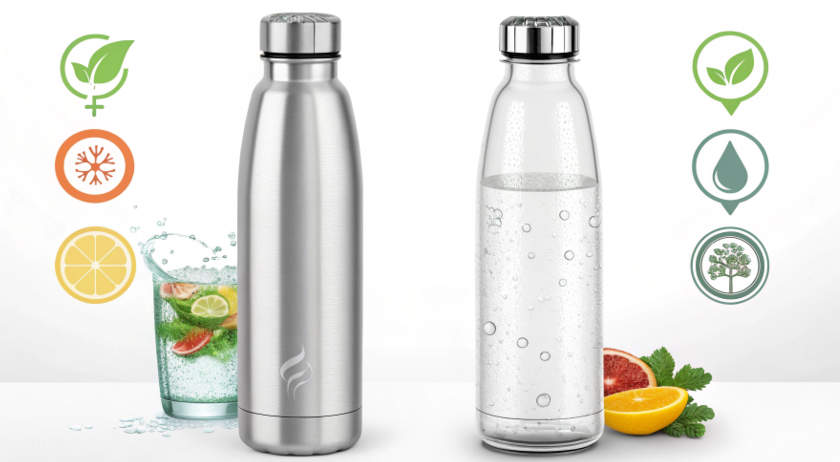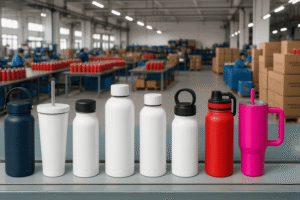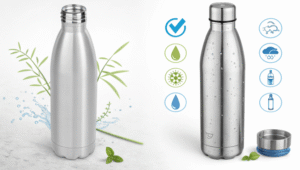Confused about which bottle material is truly safe for your customers? Choosing plastic could expose them to chemicals, but steel has its own concerns. Bad choices here can damage your brand's credibility.
Stainless steel is generally the safer choice. Food-grade stainless steel is stable and inert, meaning it doesn’t leach chemicals into your water. In contrast, many plastics, even those labeled BPA-free, can potentially release synthetic compounds, especially when heated.
In my years founding Vivimug and working with developers like Emily Chen, this safety question has become the number one concern for brands. It's not just about marketing; it's about protecting customers and your company's reputation. The science is quite clear, but it gets lost in confusing headlines. I’ve seen brands struggle with this decision. Let's cut through the noise and look at the facts so you can choose with confidence.
What is the healthiest water bottle to drink from?
You want to offer the healthiest product, but every material claims to be the best. This confusion can lead you to choose a bottle that has hidden health risks, disappointing health-conscious customers.
The healthiest water bottles are made from food-grade stainless steel or glass. These materials are non-toxic, don't leach chemicals, and won’t harbor bacteria if cleaned properly. They ensure the water you drink stays pure and free from unwanted contaminants.
!
When I consult with brands, I tell them to focus on one word: stability. A healthy container is one that does not react with its contents. This is where material science becomes crucial for a product developer. The best materials are essentially inert; they act as a neutral vessel for the water. Food-grade stainless steel, specifically types like 18/8 (or 304), is the industry standard for this reason. It's a stable alloy designed to resist corrosion and prevent any metallic taste or leaching. Glass is an equally excellent choice for purity, as it is also completely inert. However, its fragility is a major drawback for active use. The problem with plastics is their complex chemical makeup. Even "BPA-free" doesn't mean it is free from other synthetic compounds that could potentially affect health over time.
Health and Safety Profile of Bottle Materials
| Material | Chemical Purity | Risk of Leaching | Durability | Key Takeaway for Developers |
|---|---|---|---|---|
| Food-Grade Stainless Steel | Excellent | Virtually zero. Very stable. | Very High | The top choice for safety and longevity, justifying a premium price point. |
| Glass | Excellent | Zero. Completely inert. | Low to Moderate | Ideal for products promoting taste purity, but not for active or portable use cases. |
| BPA-Free Plastic (e.g., Tritan) | Fair | Low but present, especially with heat or age. | Good | A lightweight, budget-friendly option, but carries a small, persistent risk of chemical exposure. |
| Aluminum (with liner) | Depends on liner | Risk comes from the internal plastic or epoxy liner, which can degrade. | Moderate | The safety depends on the liner, not the aluminum itself. It's a less transparent choice. |
What are the disadvantages of a stainless steel water bottle?
Thinking stainless steel is the perfect solution? While it is great for safety, ignoring its downsides can lead to customer complaints about weight, cost, or unexpected dents, hurting your product's market fit.
The main disadvantages of a stainless steel water bottle are its higher manufacturing cost and heavier weight compared to plastic. It is also prone to denting upon impact, which can break the vacuum seal on insulated models.
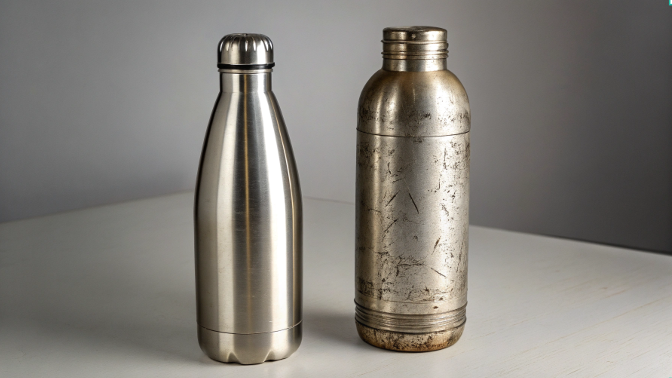
Every material choice is a trade-off. As a product developer, Emily Chen's job is not just to pick the "best" material, but the right one for a specific product and target audience. I've seen brands launch beautiful stainless steel bottles that failed because they were too heavy for their target demographic of runners. Recognizing the disadvantages is key to smart product design. The first issue is cost. Stainless steel is more expensive to source and manufacture than plastic. This means a higher price for the consumer. Second is weight. For hikers, kids, or anyone trying to minimize carry weight, the heft of a steel bottle can be a significant negative. Finally, there's the denting risk. While durable, a hard drop can leave a permanent dent. For a vacuum-insulated bottle, a serious dent can compromise the insulation by allowing the two walls to touch, rendering it ineffective.
Mitigating the Cons of Stainless Steel
| Disadvantage | Impact on User | Mitigation Strategy for Product Development |
|---|---|---|
| Higher Cost | The bottle is more expensive to purchase. | Position the product as a long-term investment. Emphasize durability and safety to justify the premium price. |
| Heavier Weight | Can be cumbersome for travel, sports, or for children to carry. | Design smaller capacity options (e.g., 12oz or 18oz) for portability. Offer single-wall versions which are much lighter than insulated ones. |
| Susceptibility to Dents | Drops can cause cosmetic damage or break the vacuum seal. | Include a protective silicone "boot" at the base of the bottle. Use a thicker gauge of steel for a more rugged, "dent-resistant" model. |
| Potential Metallic Taste | Some sensitive users may notice a taste, especially on first use. | Recommend a thorough first wash with vinegar or baking soda. Use high-quality 18/8 stainless steel, which is less prone to this issue. |
Is it healthy to drink water from a stainless steel bottle?
You hear "stainless steel" and might worry about metals like chromium and nickel. This concern can make customers hesitate, fearing that these metals could leach from the bottle into their drinking water.
Yes, it is extremely healthy. High-quality, food-grade stainless steel (like 18/8) is specifically engineered to be non-reactive and corrosion-resistant. It does not leach harmful metals or chemicals, ensuring your water remains pure and safe.
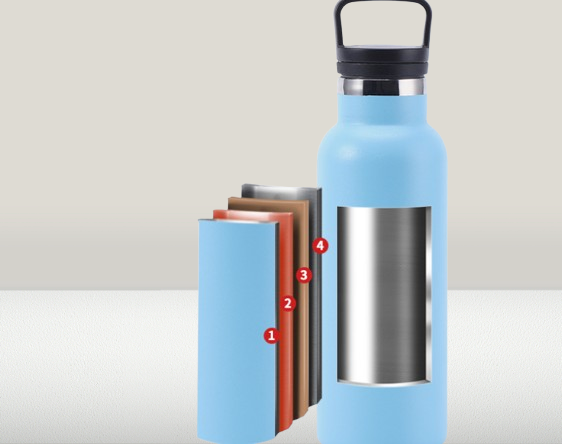
This is a concern I address constantly, and the key is in the term "food-grade." It's not just any steel. When we source materials for Vivimug, we exclusively use food-grade stainless steel, most commonly Type 304, also known as 18/8. This designation is crucial for a product developer to understand. "18/8" means the steel alloy contains 18% chromium and 8% nickel. The chromium is the magic ingredient here. It reacts with oxygen in the air to form a thin, invisible, and incredibly stable passive layer on the surface of the steel. This layer is what makes it "stainless." It self-repairs if scratched and prevents rust, corrosion, and any interaction between the steel and the water. The nickel adds to the steel's formability and durability. Because these metals are bound in a stable alloy, they don't simply flake off or leach into your drink. This is what makes it a perfectly safe, inert material for holding beverages.
Is stainless steel less toxic than plastic?
Marketing for "BPA-free" plastic can make it seem perfectly safe. This creates a false sense of security, and choosing plastic could still unknowingly expose your customers to other potentially harmful chemicals, creating a liability.
Yes, stainless steel is fundamentally less toxic than plastic. Stainless steel is an inert, stable material that does not release chemicals. In contrast, many plastics can leach synthetic compounds and shed microplastics, especially when exposed to heat, UV light, or scratches.
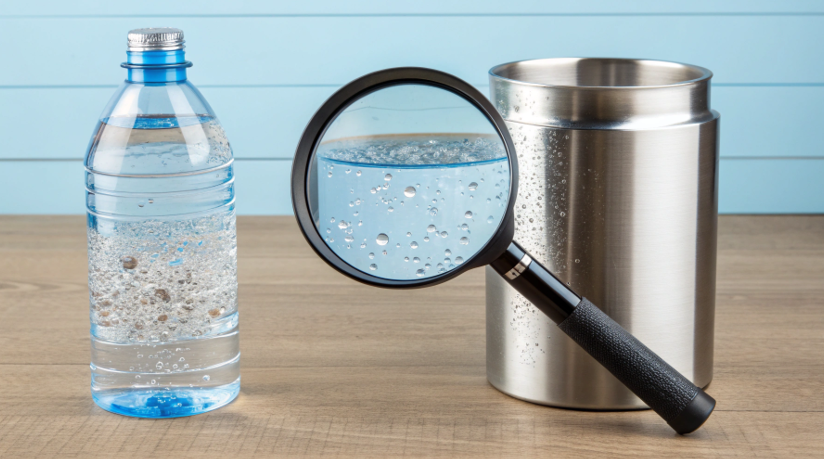
This is the most direct question and it has the most direct answer. From a materials science perspective, steel is the winner, and it's not a close race. The primary issue with plastic is its instability. Plastics are polymers made with a cocktail of chemical additives to give them specific properties like flexibility or clarity. Over time, and especially with exposure to heat (like a hot car) or UV rays from the sun, the chemical bonds can break down, allowing these additives to leach into the water. These can include endocrine disruptors like phthalates or BPA substitutes (BPS, BPF), which may be just as problematic as BPA itself. Furthermore, recent studies have shown that plastic bottles continuously shed microscopic plastic particles—microplastics—into the water. Stainless steel has none of these issues. It's a simple, stable alloy. It doesn't break down, it doesn't contain a mix of leachable additives, and it doesn't shed particles. For a brand's long-term safety and reputation, steel is the clear choice.
Safety Standoff: Stainless Steel vs. Plastic
| Safety Factor | Food-Grade Stainless Steel | Plastic (Even "BPA-Free") |
|---|---|---|
| Chemical Leaching | Virtually none. The material is inert and stable. | Potential for leaching of various synthetic compounds. |
| Risk with Heat/UV | None. Unaffected by heat or sunlight. | High. Heat and UV light accelerate chemical breakdown and leaching. |
| Microparticle Shedding | None. It is a solid, stable metal alloy. | Known to shed millions of microplastic and nanoplastic particles. |
| Long-Term Stability | Excellent. Does not degrade over its lifespan. | Degrades over time, becoming more brittle and increasing leach risk. |
Conclusion
When it comes to safety, stainless steel is the superior choice. It's stable, inert, and free from the risks of chemical leaching and microplastics that are associated with plastic bottles.
